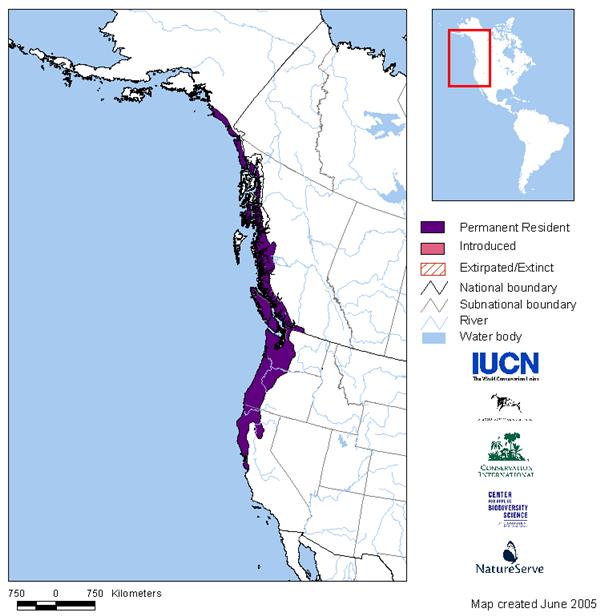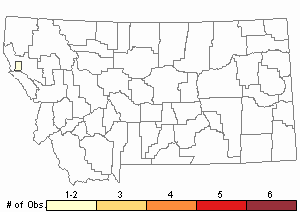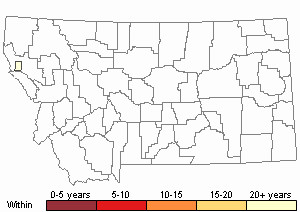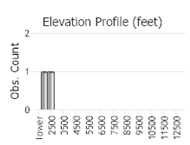View in other NatureServe Network Field Guides
NatureServe
Montana
Utah
Wyoming
Idaho
Wisconsin
British Columbia
South Carolina
Yukon
California
New York
Rough-skinned Newt - Taricha granulosa
General Description
We do not yet have descriptive information on this species. Please try the buttons above to search for information from other sources.
Species Range
Population Establishment Uncertain
Western Hemisphere Range

Range Comments
Only documented with a specimen collected near Thompson Falls in Mineral County collected in June of 1950 and an unverified observation record from the same area in 1979 (Maxell et al. 2003).
Observations in Montana Natural Heritage Program Database
Number of Observations: 2
(Click on the following maps and charts to see full sized version)
Map Help and Descriptions
Relative Density

Recency



 (Observations spanning multiple months or years are excluded from time charts)
(Observations spanning multiple months or years are excluded from time charts)
Habitat
Most common in mesophytic forests of conifers or hardwoods, although they also occur in open valleys/farmland. In lakes, concentrate in warmer shallows early then move deeper as temperature increases. Concentrate at tangled vegetation, tree roots.
Food Habits
Percent by weight data from southern BC; amphipods, 35%; terrestrial insects, 20%; tricoptera larvae, 19%; anuran larvae, 1%. Varies with prey availability. Concentrated feeding when anurans hatch.
Ecology
Move mostly during rainfall at temps above 5 °C (41 °F). Reached densities of 300/ha (up to 2700/ha near edges) in a southwestern BC lake.
Reproductive Characteristics
In southwestern BC eggs laid June to early July; metamorphose occurs in August, and they may overwinter at high elevations with metamorphosis then in June to July. Live 4 to 5 years mostly terrestrially before sexually mature.
Stewardship Responsibility
References
- Literature Cited AboveLegend:
 View Online Publication
View Online Publication Maxell, B.A., J.K. Werner, P. Hendricks, and D.L. Flath. 2003. Herpetology in Montana: a history, status summary, checklists, dichotomous keys, accounts for native, potentially native, and exotic species, and indexed bibliography. Society for Northwestern Vertebrate Biology, Northwest Fauna Number 5. Olympia, WA. 135 p.
Maxell, B.A., J.K. Werner, P. Hendricks, and D.L. Flath. 2003. Herpetology in Montana: a history, status summary, checklists, dichotomous keys, accounts for native, potentially native, and exotic species, and indexed bibliography. Society for Northwestern Vertebrate Biology, Northwest Fauna Number 5. Olympia, WA. 135 p.
- Additional ReferencesLegend:
 View Online Publication
View Online Publication
Do you know of a citation we're missing? Black, J.H. and R. Timken. 1976. Endangered and threatened amphibians and reptiles in Montana. p 36–37. In R.E. Ashton, Jr. (chair). Endangered and threatened amphibians and reptiles in the United States. Society for the Study of Amphibians and Reptiles Herpetological Circular 5: 1-65.
Black, J.H. and R. Timken. 1976. Endangered and threatened amphibians and reptiles in Montana. p 36–37. In R.E. Ashton, Jr. (chair). Endangered and threatened amphibians and reptiles in the United States. Society for the Study of Amphibians and Reptiles Herpetological Circular 5: 1-65. Boundy, J. 2001. Herpetofaunal surveys in the Clark Fork Valley region, Montana. Herpetological Natural History 8: 15-26.
Boundy, J. 2001. Herpetofaunal surveys in the Clark Fork Valley region, Montana. Herpetological Natural History 8: 15-26. Brunson, R.B. 1955. Check list of the amphibians and reptiles of Montana. Proceedings of the Montana Academy of Sciences 15: 27-29.
Brunson, R.B. 1955. Check list of the amphibians and reptiles of Montana. Proceedings of the Montana Academy of Sciences 15: 27-29. Joslin, Gayle, and Heidi B. Youmans. 1999. Effects of recreation on Rocky Mountain wildlife: a review for Montana. [Montana]: Montana Chapter of the Wildlife Society.
Joslin, Gayle, and Heidi B. Youmans. 1999. Effects of recreation on Rocky Mountain wildlife: a review for Montana. [Montana]: Montana Chapter of the Wildlife Society. Nussbaum, R.A. and E.D. Brodie, Jr. 1971. The taxonomic status of the rough-skinned newt, Taricha granulosa (Skilton) in the Rocky Mountains. Herpetologica 27(3): 260-270.
Nussbaum, R.A. and E.D. Brodie, Jr. 1971. The taxonomic status of the rough-skinned newt, Taricha granulosa (Skilton) in the Rocky Mountains. Herpetologica 27(3): 260-270. Nussbaum, R.A. and E.D. Brodie, Jr. 1981. Taricha granulosa. Catalogue of American Amphibians and Reptiles 272.1-272.4.
Nussbaum, R.A. and E.D. Brodie, Jr. 1981. Taricha granulosa. Catalogue of American Amphibians and Reptiles 272.1-272.4. Riemer, W.J. 1958. Variation and systematic relationships within the salamander genus Taricha. University of California Publications in Zoology 56(3): 301-390.
Riemer, W.J. 1958. Variation and systematic relationships within the salamander genus Taricha. University of California Publications in Zoology 56(3): 301-390.
- Web Search Engines for Articles on "Rough-skinned Newt"
- Additional Sources of Information Related to "Amphibians"





